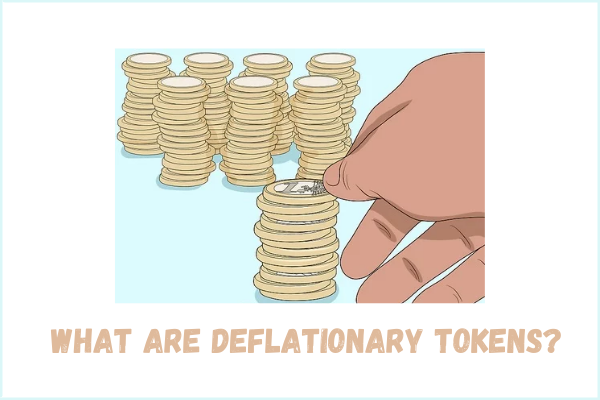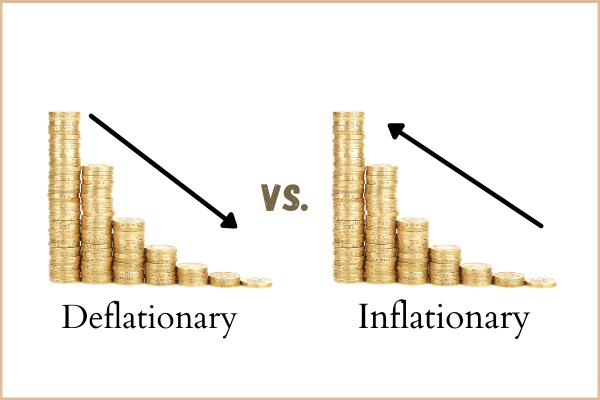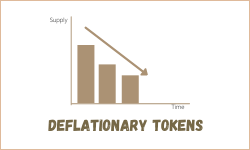In this post, I briefly described the most popular deflationary tokens.
These tokens have been making a buzz in the crypto space lately and it begs one to wonder whether deflationary tokens are doing better than other tokens in the market.
If that’s something that interests you, then you’re welcome to read this post to the end.
I also explained what deflationary tokens are and compared them with inflationary tokens.
Let’s get to it!
Post Summary
- What Are Deflationary Tokens?
- List Of Deflationary Tokens
- Deflationary Vs. Inflationary Tokens
- What Does The Future Hold For Deflationary Tokens?
- Conclusion
Click on any item above to read its details right away.
Enjoy your read!
What Are Deflationary Tokens?

Deflationary tokens are tokens fashioned to reduce in supply over time.
That is to say, the circulating supply of the token reduces as the years pass.
The essence is to prevent the market from being flooded with the token while improving the value of the token.
A good example is a coin that reduces its supply by 2% every year.
If there were 20,000 coins in supply in 2019, by 2020 it will be 18,600 coins, 18,228 coins by 2020, 17,863.44 coins by 2021, and so on.
As the coin becomes more limited in supply, its demand will increase and so will its value. Cool!
Crypto projects of the deflationary token model achieve their goals in different ways but the 2 major methods to remove coins from the market are:
a. Buy-Back and Burn
This is where the company in charge of the project buys back a good portion of its coins from the market and burns them.
It burns the coins by sending them to a dead address. So, it lowers the circulating supply by destroying tokens.
This results in an increase in the value of the coin because the demand remains the same (or increases) while the supply has reduced.
The top tokens using this method are BNB, FTT, and CAKE.
b. Burn On Transaction
Here, the contract of the coin specifies that a percentage of the tax collected from on-chain transactions will be burned.
In other words, on-chain transactions involving the coin attract a tax and a percentage of the tax collected is burned.
This happens automatically because it is integrated into the coin’s contract.
Also, its success depends on the trading volume of the coin because deductions will only be made when transactions occur.
So, the higher the trading volume, the more tokens are removed from the total supply.
Thus, driving value to token holders as tokens are constantly removed from circulation while demand remains constant (and possibly increases).
Some tokens that use this method are SAFEMOON and THUGS.
Confused about the concept of coin burn? Read this post for a clearer picture – Is “Coin Burn” Behind The Parabolic Price Action of Cryptocurrencies?
I briefly described the popular deflationary tokens in the next section.
Tag along!
List Of Deflationary Tokens

1. Bitcoin (BTC)
The first coin on my list of deflationary tokens is a tricky one as most persons believe that bitcoin is both inflationary and deflationary.
Inflationary in the sense that more coins are added to the supply via its mining process and deflationary because miners’ rewards are halved every 4 years.
Also, the maximum supply of Bitcoin contributes to its deflationary model.
There will only ever be 21 million Bitcoins mined.
Once that is achieved, no new coins will be created, and no more block rewards will be given.
Additionally, the circulating supply of BTC will reduce when private keys are lost and coins become irretrievable.
Interesting!
Get the full gist about bitcoin here.
2. Binance Coin (BNB)
BNB, the native token of the Binance Network is also a deflationary token.
It uses the Buy-Back and Burn approach.
At every quarter of the year, the team at Binance burns a fraction of the BNB coin.
They achieve this by repurchasing BNB from its investors with more than a 20% profit made in the last quarter and then send them to an unspendable address.
Initially, BNB had a total supply of 200 million coins. The plan is to burn half of its supply that is, 100 million coins.
The last burn (16th BNB burn) happened in June 2021 and a total of 1,296,728 BNB (roughly $393,673,653.52) was burned.
Right now (16/08/2021), the total supply of BNB is 168,137,036 coins.
Learn more about BNB here.
3. Crypto.com (CRO)
CRO is the native token of Crypto.com, a renowned cryptocurrency exchange.
Prior to the launch of its mainnet in March 2021, Crypto.com burned 70 billion CRO (roughly $10 billion).
Out of the 70 billion coins, 59.6 billion CRO were burned outrightly while 10.4 billion will be burned monthly as tokens are unlocked from smart contracts.
Before the burn, CRO was priced at $0.08, now, 4 months after the burn, the price is approximately $0.15.
Cool, right?
There’s more story to this coin. Find out here.
4. Ripple (XRP)
XRP is another popular coin that made my list.
Ripple charges some fees to conduct transactions.
These fees are neither returned to a central authority nor paid as a reward to the validators, rather, they are burned, making XRP a deflationary token.
Read our review of XRP to learn more.
5. PancakeSwap (CAKE)
CAKE is the native token of the PancakeSwap ecosystem.
It does not have a maximum supply which makes it inflationary but then it employs a Coin Burn mechanism to keep its supply in check.
CAKE’s supply is reduced per block at (-18), and per day at (-560,400).
Find more details here.
6. Solana (SOL)
Solana is one of the latest blockchains that is making waves in the cryptocurrency space.
Just like Bitcoin, it is both deflationary and inflationary.
A good look at its coin distribution and capless supply shows that it is inflationary
But the burning of Solana transaction fees (paid in SOL) makes it deflationary.
Read all about SOL here.
7. Litecoin (LTC)
Here’s another Bitcoin look-alike that made my list of deflationary tokens.
Litecoin mining rewards are halved every 4 years.
This means that the production of LTC decreases over time and will eventually stop once the supply reaches 84,000,000 coins.
Learn more about LTC here.
8. Bitcoin Cash (BCH)
BCH also made my list of deflationary tokens.
In addition to its capped supply of 21,000,000 coins, it halves miners’ reward every 4 years, reducing the circulating supply.
Moreover, Bitcoin Cash has seen its price value rise as a result of coin burn.
When Antpool (a cryptocurrency mining pool that validates nearly 10% of BCH’s transactions) announced the burning of 12% of the BCH it received as block rewards in 2018, the coin’s price went up significantly.
Plus, Wormhole, a blockchain project also burns BCH to create an equivalent amount of its native token WHC.
Amazing!
9. Terra (LUNA)
LUNA, the native coin of the Terra ecosystem also made my list of deflationary tokens.
It is the stability mechanism behind the Terra stablecoin.
The maximum supply of LUNA is 1 Billion and all were issued at genesis.
Therefore, as the demand for Terra stablecoins increases, the circulating supply will only reduce over time.
Get the full gist of LUNA here.
10. Polygon (MATIC)
MATIC is the native token of the Polygon Network.
It serves two major purposes: to pay transaction fees and to participate in its PoS consensus mechanism.
According to its docs, a percentage of the transaction fee in every block is burned to provide constant support for the coin’s value.
Read our review of MATIC to learn more.
11. Ethereum Classic (ETC)
ETC is an interesting coin that made my list of deflationary tokens.
Its block reward was initially set at 5 ETC and decreases by 20 percent every 5 million blocks (approximately every 2.5 years).
Also, the total supply of ETC is not expected to exceed 230 million coins.
You may like this – Bitcoin Halving Is Changing Crypto – This Is The Complete List Of Coins That Halve
12. SafeMoon (SAFEMOON)
SAFEMOON is a deflationary token that was created to solve the problem with ‘farming’ rewards, where early stakers earn from the highest APYs and newcomers don’t earn much.
One way this goal is achieved is through manual burns.
Also, it employs the Burn On Transaction approach as aforementioned.
Trading SAFEMOON attracts a 10% transaction tax charge.
2.5% of this charge is sold by the contract into BNB (burning).
Learn more about SAFEMOON here.
13. Tenset (10SET)
10SET is the Tenset’s native token and it is deflationary.
There is an attached 2% fee for every 10SET transfer.
Half of the fee is burned to reduce the number of 10SETs in circulation.
Learn more about this coin here.
14. Filecoin (FIL)
FIL is the native asset of the Filecoin blockchain, an open-source, decentralized storage, and content delivery network.
The coin made my list because of its capped supply (2 billion FIL).
Also, mining rewards for Filecoin are halved every six years.
Plus, transaction fees paid in FIL are burned, reducing the circulating supply.
Some FIL coins are also burned to fund on-chain computations and bandwidth as network message fees.
15. TRON (TRX)
TRON is a blockchain network that is committed to promoting the decentralization of the Internet.
Its native token – TRX, transited from inflationary to deflationary in April 2021.
This was achieved by cutting the total supply of TRX from 101,678,790,175 to 101,673,029,723.
The action was in response to a proposal from the TRON community.
Read more about TRX here.
16. BOMB (BOMB)
BOMB describes itself as the ‘world’s first self-destructing currency’
In every BOMB transaction, 1% of the tokens are destroyed.
At this rate, none of the 1 million BOMB tokens will be left by 2034.
Oh my…
This coin is more of a social experiment than an everyday currency.
Though it has made some investors smile, its price action shows that deflation does not automatically produce an increase in price. Oops!
17. NUKE (NUKE)
NUKE is another deflationary token that made my list.
It has a 1 million max token supply with a 2% burn rate.
But the burning is estimated to stop around 2036.
NUKE is a lot like BOMB but it intends to have real applications, starting with the launch of a native DEX. 🙂
Other deflationary tokens that didn’t make my list are:
- FTT
- CRED
- CRNC
- TABOO
- OPTI
- VOIDX
- CBN
- SWAP
- CUMMIES
- HOPE
- BINGUS
- ADGNZ
- THUG
- ADA, etc.
In the next section, I compared deflationary and inflationary tokens.
Check it out!
Deflationary Vs. Inflationary Tokens

While deflationary tokens decrease in supply over time, inflationary tokens increase in supply.
And though deflation helps the price of a coin, it is not in all cases.
Some deflationary tokens are not doing well as we saw in the BOMB token.
Moreover, most inflationary tokens like ETH and EOS are doing well in the market.
We can trace their success to the fact that the inflationary tokenomics model is well understood as it is operational in the traditional monetary policy structure.
Also, it has proven to be a suitable way to sustain value and incentivize network participation.
Therefore, deflationary tokens are not necessarily better than inflationary tokens because of the tendency of positive price action.
Tokens of both models work independently and have shown appreciable growth so far.
The success of a coin depends largely on the diligence of its developer team to follow its road map and also on mass adoption.
Nevertheless, we cannot ignore the impact deflation can have on the value of coins (as BNB reveals). 😜
So, is the future bright for deflationary tokens?
Find out what I think in the next section…
What Does The Future Hold For Deflationary Tokens?
After studying the coins above, I observed that the success of deflationary tokens does not rely solely on the deflation system even though it contributes to it.
The tokens that are doing well have a solid team behind them and also enjoy mass adoption.
Truth be told, investors want to utilize their tokens for profit.
Where that is not happening, they will lose interest in the coin, and it will crash even with deflation.
Additionally, it is only when a company is performing well that it can buy back coins from the market.
If a company cannot afford to buy back coins from the market, the coin will saturate the market and the value will eventually drop.
On the other hand, if the company performs well, more tokens can be bought from the market thereby improving the health of its ecosystem.
Another point of concern is that putting a limit to the number of tokens to be minted (which is the case of most deflationary tokens) will likely incentivize users to hodl and hodl.
Such tokens may go out of circulation and eventually lose the deemed value. Ouch!
Bottom line, there is no guarantee that deflationary tokens will do well simply because of deflation.
A company must endeavor to follow all necessary guidelines surrounding the distribution and sale of its token for success.
Look at this 👇

Conclusion
This is where we’ll draw the drapes in our discussion on deflationary tokens. I hope it was worth your time.
We established that deflationary tokens will not succeed simply because of deflation.
But the company involved must ensure that the coin has real applications and excellent distribution/sale.
Now, I’d love to hear from you; what do you think of deflationary tokens? Will they out-do other coins in the long run?
Are there other tokens that you feel should have made my list?
Let your fingers do the talking for you in the comments section. 😉
Also, share this post on your way out, thank you! 🙏



0 Comments